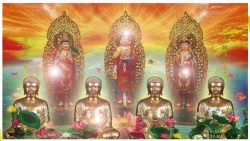Bhaisajyaraja
bhaiṣajyarāja and Bhaiṣajy asamudgata, two bodhisattvas mentioned in the Saddharmapuṇḍarīkasūtra (“Lotus Sūtra”), are likely antecedents, and similarities with other “celestial” buddhas like AMITĀBHA and AKṢOBHYA also suggest possible influence from those rival cults. The Bhaiṣajyagurusūtra was translated into Chinese in the seventh century, during the Tang dy nasty, when his
worship finally achieved the wide recognition that it continues to enjoy within the Chinese tradition. The Bhaiṣajyagurusūtra is also cited in the eighth-century tantric text, Mañjuśrīmūlakalpa, indicating that his cult had by then achieved widespread acclaim throughout Asia.
Bhaiṣajy aguru was one of the earliest buddhas to gain popularity in Japan, although initially he was familiar only within the imperial court, which constructed monasteries in his honor beginning in the sixth century. By the eighth century, his cult had spread throughout the country, with Bhai ṣajy aguru being invoked both to cure illness and to ward off dangers. The
worship of Bhaiṣajy aguru seems to have entered Tibet during the eighth century, two versions of the Bhaiṣajyagurusūtra having been translated into Tibetan by the prolific YE SHES SDE and others. Early in the development of his cult, Bhaiṣajy aguru was divided into a group of eight medicine buddhas (aṣṭabhaiṣajy aguru), made up of seven of his emanations plus the principal buddha. Their names vary according to source, and none save Bhaiṣajy aguru are worshipped individually.
Two of these emanations—Sūry aprabha and Candraprabha—are often depicted in a triad with Bhaiṣajy aguru. Further, Bhaiṣajy aguru is also said to command twelve warriors (yakṣa) related to various astrological categories and to wage war on illness in the name of their leader. Indic images of Bhaiṣajy aguru are rare, but his depictions are common across both the East Asian and Tibetan cultural spheres. East Asian images are almost uniform in depicting him seated, with his right hand in the gesture of fearlessness (abhayamudrā) or the gesture of generosity.
Source
The Princeton Dictionary of Buddhism by Robert E. Buswell Jr. and Donald S. Lopez Jr.
